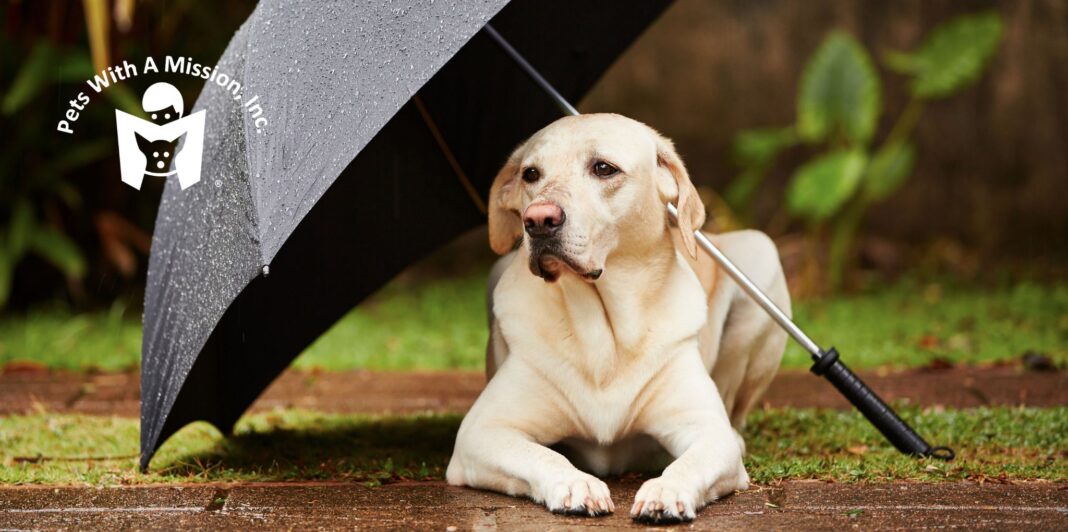Pets With A Mission inc: Wind and Rain and Pets, Oh My!
It’s June! You live in Texas so welcome to hurricane season. The season starts June 1 and ends November 30 each year. Some years the storms go to other locations and miss Texas completely. But every once in a while our area becomes the bullseye for a tropical storm or hurricane. People think that the impact of hurricanes are always worse than those of tropical storms but that is not necessarily true. In June 2001, Tropical Storm Allison parked over Houston for days, dumped 38 inches of rain on the city, and produced significant wide-spread flooding. Even 100 miles inland from the coast received 8 inches of rain in just two days. Tropical storms, with their tornados, damage property and knockout electricity to thousands of people for days, weeks, or even months. Ok, you say, tropical systems bring dangerous winds and rains, but what does that have to do with animals? Well, unfortunately, it has a lot to do with family pets and livestock. Have you made plans for you and your animals to weather the storms?
If you decide to stay in place during a tropical storm, you will need a safe place for people and pets, plenty of water and nonperishable food for everyone for a minimum of three days. Since your usual water supply may be interrupted, it is important to store containers of water for drinking and other uses. As a reminder, bring in your outside animals inside or confine them is a secure structure such as a sturdy barn. For livestock herds that cannot be put in a barn, move them to higher ground to keep them out of areas that are likely to flood. After the storm passes, check on all animals and treat any injuries they may have received. In addition, be on the lookout for unwanted displaced visitors such as fire ants and snakes who may cause injuries to pets and people.
Staying in place is probably the option most people would prefer to follow. But depending on the expected storm track, forecast weather conditions, and how sturdy your home is, evacuation, voluntary or directed, may be the best course of action. If you evacuate, take all your pets with you because if it is not safe enough for you to stay in place, it is not safe for your animals either. If you have a horse, a few goats, or other livestock that can be loaded on a stock trailer, please take those animals with you, too. Evacuation may be accomplished in one of two ways. The first way is to plan ahead and execute that plan so you know where you are going and what you need to take with you are taking before you leave home. The other way is to leave home in a panic and hope that you did not forget to pack any essential items.
There is a lot to consider when evacuating with animals. Where will you go? If you plan to stay with family or friends, verify with them that your animals will be welcome. If not, other arrangements must be made. Maybe a hotel or motel outside the storm area will be your destination. Most likely, you will face competition to book a room because many other people will be evacuating at the same time. In addition, not all hotels and motels accept animals or they may charge excessive pet deposits that may or may not be refundable. Therefore, it is a good idea to keep a list of pet friendly places on hand rather than scrambling to find one in an emergency. This is especially important if you are not very familiar with the area you will be evacuating to.
Another option is to board you animals in a kennel near your evacuation location, not in your home area. Kennels near your home are subject to the same winds and floods as your own home. Finding a kennel may be a challenge. If a storm arrives during prime vacation travel time, kennels may be full and unable to take your pets. Also, some kennels only board certain species. Finding a kennel to board dogs is much easier than locating a facility that will accept cats, rabbits, birds, etc.
Going to a storm shelter is another option. After Hurricane Katrina, television news showed several hundred animals that were left behind to fend for themselves when their people evacuated from New Orleans. The primary reason for pet abandonment was because shelters and bus transport would not accept pets. It was a deplorable situation but it did produce changes. Today, most shelters will allow people to bring their pets with them. Some shelters will allow pets to remain with their families inside the shelter while others have arrangements for pets to be sheltered in a nearby facility such as the local fairgrounds. Each pet will need a crate or carrier appropriate for their size, food and water bowls, food, some cleaning supplies, medicines, and a leash with collar or harness. It is recommended that you bring an immunization record for each animal and a current photo that includes one or more family members. The record and photo can be used as proof of your ownership and for identification should your pet escape from confinement.
There are several good online sources that have evacuation checklists and additional helpful information. Some very knowledgeable sources that you may want to check out are:
American Veterinary Medicine Association
www.avma.org/resources/pet-owners/emergency
Centers For Disease Control and Prevention
www.cdc.gov/healthypets/emergencies
American Kennel Club
American Society for the Prevention of Cruelty to Animals















